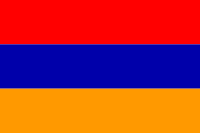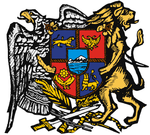Democratic Republic of Armenia
|
|||||||||||||||||||||||||||||||||||||||||||||||
The Democratic Republic of Armenia (DRA; Armenian: Հայաստանի Դեմոկրատական Հանրապետութիւն, Hayastani Demokratakan Hanrapetut’yun; also known as the First Republic of Armenia) was the first modern establishment of an Armenian republic. The republic was established in the former territory of Eastern Armenia in the Russian Empire following the Russian Revolution of 1917. The leaders of the government came from the Armenian Revolutionary Federation (also known as the ARF or Dashnaktsutyun) and other Armenian political parties who helped create the new republic. When it was established, it bordered the Democratic Republic of Georgia to the north, the Ottoman Empire to the west, Persia to the south, and the Azerbaijan Democratic Republic to the east.
From the very onset, the DRA was plagued with a variety of domestic and foreign problems. Many of its inhabitants were Armenian refugees who had fled the massacres of the Armenian Genocide in Western Armenia and it almost did not come into existence because of the advances of the armies of the Ottoman Empire, which were intent on eliminating the Armenian people living in the area.[4]
The republic lasted for two years, until 1920, when it was finally overwhelmed by the Mustafa Kemal Ataturk's Turkish Nationalist forces and Soviet Russia.
Contents |
Background
The Russian offensive during the Caucasus Campaign of World War I and subsequent occupation and the creation of a provisional administrative government gave hope for the liberation of Western Armenia from Ottoman Turkish rule. With the help of a several battalions of Armenians recruited from the Russian Empire, the Russian army had made progress on the Caucasus Front, advancing as far as the city of Erzerum in 1916. The Russians continued to make considerable advances even after the toppling of Tsar Nicholas II in February 1917.
In March 1917, the spontaneous revolution that toppled Tsar Nicholas and the Romanov dynasty established a caretaker administration, known as the Provisional Government. Shortly after, the Provisional Government replaced Grand Duke Nicholas' administration in the Caucasus with the five-member Special Transcaucasian Committee, known by the acronym Ozakom. The Ozakom included Armenian Democrat Mikayel Papadjanian, and was set to heal wounds inflicted by the old regime. In doing so, Western Armenia was to have a general commissar and was to be subdivided into the districts of Trebizond, Erzerum, Bitlis, and Van.[5] The decree was a major concession to the Armenians: Western Armenia was placed under the central government and through it under immediate Armenian jurisdiction. Dr. Hakob Zavriev would serve as the assistant for civil affairs and he in turn would see to it that most civil officials were Armenian.
Things took a turn for the worse, however, in October 1917, when the Bolsheviks seized power from the Provisional Government and announced that they would be withdrawing troops from both the Western and Caucasus Fronts.[6] The Georgians, Armenians and Muslims of the Caucasus all rejected the Bolsheviks' legitimacy.
Towards independence
| History of Armenia | |
|---|---|
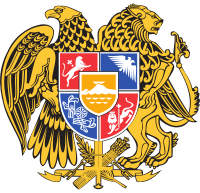 This article is part of a series |
|
| Ancient Armenia | |
| Name of Armenia | |
| Hayk | |
| Hayasa-Azzi | |
| Nairi | |
| Urartu | |
| Antiquity | |
| Orontid Armenia | |
| Kingdom of Armenia | |
| Kingdom of Sophene | |
| Kingdom of Commagene | |
| Lesser Armenia | |
| Artaxiad Dynasty | |
| Roman Armenia | |
| Arsacid Dynasty | |
| Medieval history | |
| Marzpanate Period | |
| Byzantine Armenia | |
| Arab conquest of Armenia | |
| Emirate of Armenia | |
| Bagratuni Armenia | |
| Kingdom of Vaspurakan | |
| Armenian Kingdom of Cilicia | |
| Zakarid Armenia | |
| Foreign rule | |
| Persian · Ottoman · Russian | |
| Armenian national movement | |
| Hamidian massacres | |
| Armenian Genocide | |
| Contemporary Armenia | |
| Democratic Republic of Armenia | |
| Armenian Soviet Socialist Republic | |
| Republic of Armenia | |
|
Armenia Portal |
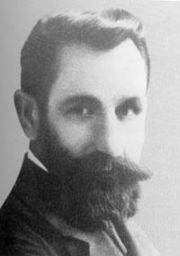
On December 5, 1917, the armistice of Erzincan was signed between the Russians and Ottomans, ending armed conflicts between the two states. After the Bolshevik seizure of power, a multinational congress of Transcaucasian representatives met to create a provisional regional executive body known as Transcaucasian Seim. The Commissariat and the Seim were heavily encumbered by the pretense that the South Caucasus formed an integral unit of a non-existent Russian democracy.[7] The Armenian deputies in the Seim were hopeful that the anti-Bolshevik forces in Russia would prevail in the Russian Civil War, and they "persistently rejected the slightest suggestion of separation from Russia."[8] In February 1918, the Armenians, Georgians and Muslims had reluctantly joined to form the Transcaucasian Federation but disputes among all the three groups continued as unity began to falter.
On March 3, 1918, the armistice of Erzincan was followed up with the Treaty of Brest-Litovsk, marking Russia's exit from the war. From March 14 to April 1918, conference was held between the Ottoman Empire and the delegation of the Seim. In the Treaty of Brest-Litovsk, the Turks were allowed to regain the Western Armenian provinces and even were even allowed to take over Batum and the Russian Armenian provinces of Kars and Ardahan. In addition to these provisions, a secret clause was inserted which obligated the Armenians and Russians to demobilize their forces in both western and eastern Armenia.[9] Having massacred and deported the Armenians of Western Armenia during the Armenian Genocide, the Ottoman Empire now set its sights on eliminating the Armenian population of Eastern Armenia.[10] Shortly after the signing of Brest-Litovsk, the Turkish army began its advance, taking Erzerum in March and Kars in April. Beginning on May 21, the Ottoman army moved ahead once again.
On May 11, 1918, a new peace conference opened at Batum. At this conference, Ottomans extended their demands to include Tiflis, as well as Alexandropol and Echmiadzin which they wanted a railroad to be built to connect Kars and Julfa with Baku. The Armenian and Georgian members of the Republic’s delegation began to stall. On May 26, 1918, Georgia declared independence; on May 28, it signed the Treaty of Poti, receiving protection from Germany.[11]. The following the day, the Muslim National Council in Tiflis announced the establishment of the Democratic Republic of Azerbaijan.
Having been abandoned by its regional allies, the Armenian National Council, based in Tiflis and led by Russian Armenian intellectuals who represented Armenian interests in the Caucasus, was forced to declare its independence on May 28.[12] It dispatched Hovhannes Kachaznuni and Alexander Khatisyan, both members of the ARF, to Yerevan to take over power there and issued the following statement on May 30 (retroactive to May 28):
In view of the dissolution of the political unity of Transcaucasia and the new situation created by the proclamation of the independence of Georgia and Azerbaijan, the Armenian National Council declares itself to be the supreme and only administration for the Armenian provinces. Because of the certain grave circumstances, the national council, deferring until the near future the formation of an Armenian National government, temporarily assumes all governmental functions, in order to take hold the political and administrative helm of the Armenian provinces.[13]
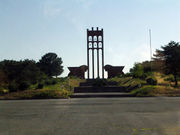
Meanwhile, the Turks had taken Alexandropol and were intent on eliminating the center of Armenian resistance based in Yerevan. The Armenians were able to stave off total defeat and delivered crushing blows to the Turkish army in the battles of Sardarapat, Karakilisa and Abaran.
Nevertheless, it was forced to sue for negotiations at Treaty of Batum. It was signed in Batum on June 4 1918. It was the first treaty of the Democratic Republic of Armenia. After the Ottoman Empire took vast swaths of territory and imposed harsh conditions, the new republic was left with a mere 4,400 square kilometers.[14]
Administration
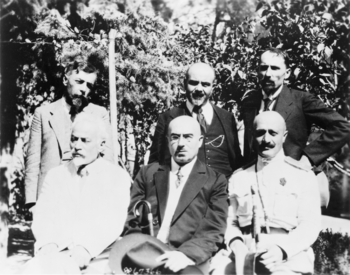
On May 30, 1918 the Armenian Revolutionary Federation had decided that Armenia should be a republic under a provisional coalition government. The declaration stated that the Republic of Armenia was to be a self-governing state, endowed with a constitution, the supremacy of state authority, independence, sovereignty, and plenipotentiary power. Katchaznouni became the country's first Prime Minister and Aram Manougian was the first minister of Interior.
Armenia established a Ministry of Interior and created a police force. The Armenian parliament passed a law on the police on April 21, 1920, specifying its structure, jurisdiction, and responsibilities. The Interior Ministry was also responsible for communications and telegraph, railroad, and the public school system, in addition to enforcing law and order. The reforms come soon and each of these departments became ministries.
In 1919, the leaders of the Republic had to deal with issues on three fronts: domestic, regional, and international. The Armenian Congress of Eastern Armenians that took control in 1918 fell apart and in June 1919, the first national elections were held. The establishment of law was a problem: Armenians had the most organized structure in their homeland; however, several other ethnic groups had been settled for many centuries in these lands, too (Kurds and Azeris were the major ones). During the 1920s, which began under the premiership of Kachaznuni, Armenians from the former Russian Empire and United States developed the judicial system. January 1919 was an important milestone as the country's first state university was founded.
Military
Thanks to the efforts of Armenian National Council in Tiflis, an Armenian military corps was established to fight against the Ottoman invasions of late 1917 and early 1918. Units of this corps formed the basis of the DRA's army. In accordance with the harsm terms of the Treaty of Batum signed on June 14, 1918 Turkey permitted the Armenians army to maintain just a single infantry division. Following the Mudros Armistice, the size of the army expanded to 16,000 people; by the end of 1919 there were 20,000 men and in November 1920, there were 40,000 men. In October 1918, the Ministry of Military Affiars was formed and headed by Hovhannes Hakhvrdian; he was later succeeded by Kristopor Araratian, Ruben Ter-Minasian and finally Drastamat Kanayan (Dro).
Geography
The Democratic Republic of Armenia had include following areas of the former Russian Empire divisions.[15]
| Districts (okrugs) | Parts | |
|---|---|---|
| Erivan Governorate | ||
| All | All | |
| Kars Oblast | ||
| Kars | All | |
| Kaghzvan | All | |
| Olti | Major part | |
| Ardahan | Major part | |
| Elisabethpol Governorate | ||
| Zangezur | All | |
| Kazakh | mountainous part (Ijevan subdistrict) | |
| Tiflis Governorate | ||
| Borchalu | half (Lori subdistrict) | |
Population

Before World War I, in 1914, the Armenian Republic was part of Russian Armenia and among the total Armenian population of 2,800,000, only about 1,500,000 were in the Ottoman Empire, and the remainder were in the Russian Armenia.[16] During 1918, the new Armenian Republic's first year, Armenia had many migrations (population relocations). An estimate in 1918 indicated that there were 800,000 Armenians and more than 100,000 Muslims which included mostly Osmanli or Ottoman Turks in Kars, and Azeri Turks and Kurds everywhere else. Of the 800,000 Armenians, about 500,000 were native Russian Armenians and 300,000 were destitute and starving refugees fleeing from the massacres that took place in the Ottoman Empire.[17]
The surviving Armenian population in 1919 was 2,500,000 which 2,000,000 were distributed in the Caucasus.[3] Out of these 2,000,000 in the Caucasus, 1,300,000 were to be found within the boundaries of the new Republic of Armenia, which included 300,000 to 350,000 refugees who had escaped from the Ottoman Empire.[3] There were 1,650,000 Armenians in the new Republic.[3] Also added to this Armenian population were 350,000 to 400,000 people of other nationalities, and a total population of about 2,000,000 within the Armenian Republic.[3]
The surviving Armenian population in 1921 was 1,200,000 in Republic, 400,000 in Georgia, 340,000 Azerbaidjan and with the other regions in the Caucasus adds to 2,195,000.[18]
Refugee problem
There was also an Armenian settlement problem that brought conflict with other ethnic residents. In all, there were over 300,000 embittered and impatient Armenian refugees escaping from the Ottoman Empire which were now the government's responsibility. This proved an insurmountable humanitarian issue. Typhus was a major sickness, because of its effect on children. Conditions in the outlying regions, not necessarily consisting of refugees, weren't any better. The Ottoman governing structure and Russian army had already withdrawn from the region. The Armenian government had neither time nor resources to rebuild the infrastructure. The 393,700 refugees were under their jurisdiction as follows:
| Districts | Number of refugees |
|---|---|
| Erevan | 75,000 |
| Ashtarak | 30,000 |
| Akhta-Elenovka | 22,000 |
| Bash-Garni | 15,000 |
| Novo-Bayazit | 38,000 |
| Daralagyaz | 36,000 |
| Bash-Abaran | 35,000 |
| Ejmiatsin | 70,000 |
| Karakilisa | 16,000 |
| Dilijan | 13,000 |
| Armenia | 350,000 |
The government of Hovhannes Kachaznuni was faced with a most sobering reality in the winter of 1918-19. The newly formed government was responsible for over half a million Armenian refugees in the Caucasus. It was a long and harsh winter.[19] The homeless masses, lacking food, clothing and medicine, had to endure the elements. Many who survived the exposure and famine succumbed to the ravaging diseases. By the spring of 1919, the typhus epidemic had run its course, the weather improved and the first American Committee for Relief in the Near East shipment of wheat reached Batum. The British army transported the aid to Yerevan. Yet by that time some 150,000 of the refugees had perished. Vratsian puts this figure at around 180,000, or nearly 20% of the entire nascent Republic. A report in early 1919 noted that 65% of the population of Sardarabad, 40% of the population of eight villages near Etchmiadzin and 25% of the population of Ashtarak had died.
Foreign relations
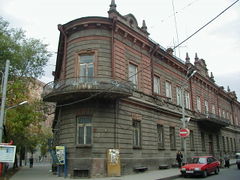
In 1920, the Republic of Armenia administered an area that covered most of present-day Armenia, Kars, Igdır, and the Çıldır and Göle districts of Ardahan, while the regions of Nakhchivan, Nagorno-Karabakh, Zangezur (today the Armenian province of Syunik), and Qazakh were disputed and fought over with Azerbaijan. The Oltu region (briefly administered by Georgia in 1920) was also claimed by the DRA. The majority-Armenian area of Lori was disputed with and administered by Georgia. The areas south of Yerevan which were populated by Muslims did not acknowledge Armenian authority and resisted attempts by the Armenian government to assert its control over those regions.[20] Nevertheless, after the signing of the Treaty of Sèvres in 1920, Armenia was granted formal international recognition. The United States, as well as some South American countries, officially opened diplomatic channels with the government. Numerous Armenian missions were also established in Great Britain, Italy, Germany, Serbia, Greece, Iran, Japan and Africa.[21]
Georgian-Armenian war
In December 1918, Armenia and Georgia engaged in the Georgian–Armenian War 1918, which was a brief military conflict over the disputed marshlands in the largely Armenian-populated Lori district along with some other neighboring regions. It was claimed by both nations but had been taken by Georgia after the Ottomans' evacuation of the area. The fighting continued with varying success for two weeks. Despite initial success, the Armenian offensive under Drastamat Kanayan was finally halted and the war ended through the British mediation, establishing a joint Armeno-Georgian civil administration in the "Lori neutral zone" or the "Shulavera Condominium."[22]
Relations between Armenia and Georgia, however, remained tense. In the spring of 1919, American relief agency officials began to complain that railway traffic to Armenia and vital supplies of flour and other foodstuffs destined there were being deliberately held up by the Georgian authorities, who demanded their own share of the provisions.[23] Moved by their complaints and the debilitating food crisis in Armenia, Georges Clemenceau, as president of the Versailles Conference, issued a protest letter on July 18, calling on Georgia to cease further interference. Georgia issued its own protest to this communiqué, but by July 25, reports from American officials stated that the rail traffic had begun to pick up.[24] In autumn 1919, Armenia and Georgia began negotiations for a new transit treaty.
Armenian-Azerbaijan War
A considerable degree of hostility existed between Armenia and its new neighbor to the east, the Democratic Republic of Azerbaijan, stemming largely from to racial, religious, cultural and societal differences. The Azeris had close ethnic and religious ties to the Turks and had provided material support for them in their drive to Baku in 1918. Although the borders of the two countries were still undefined, Azerbaijan claimed most of the territory Armenia was sitting on, demanding all or most parts of the former Russian provinces of Elizavetpol, Tiflis, Yerevan, Kars and Batum.[22] As diplomacy failed to accomplish compromise, even with the mediation of the commanders of a British expeditionary force that had installed itself in the Caucasus, territorial clashes between Armenia and Azerbaijan took place throughout 1919 and 1920, most notably in the regions of Nakhichevan, Karabakh and Syunik (Zangezur). Repeated attempts to bring these provinces under Azerbaijani jurisdiction were met with fierce resistance by their Armenian inhabitants.[25] In May 1920, Kanayan led an expeditionary unit that was successful in establishing Armenian administrative control in Nakhichevan.[26]
South West Caucasian Republic
While problems with Azerbaijan continued, a new state headed by Fakhr al-Din Pirioghlu and centered in Kars, the South West Caucasian Republic was established. It claimed the territory around the regions of Kars and Batum, parts of the Yerevan district and the Akhaltsikhe and Akhalkalaki districts of the Tiflis province. It existed alongside with the British general governorship created during the Entente's intervention in Transcaucasia.[27] It was abolished by British High Commissioner Admiral Somerset Arthur Gough-Calthorpe in April 1919 and the region was assigned to the Armenian Republic.
Treaty of Sèvres

The Treaty of Sèvres was signed between the Allied and Associated Powers and Ottoman Empire at Sèvres, France on August 10, 1920. The treaty included a clause on Armenia: it made all parties signing the treaty recognize Armenia as a free and independent State. The borders drawn in the treaty reflected the efforts made by Armenians in the defeat of the Ottoman Empire in the Caucasus Campaign. This treaty was signed by the Ottoman Government, but Sultan Mehmed VI never signed the treaty; hence the treaty never came into effect. Turkish Revolutionaries began a Turkish National Movement which, in turn, sought to crush the republic.
Turkish-Armenian War and Sovietization
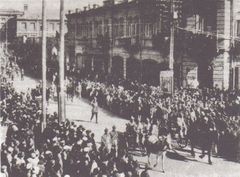
The Turkish Revolutionaries alleged that the Turks inside DRA were being mistreated and oppressed by the Armenians. On September 20, 1920, the Turkish General Kazım Karabekir invaded the borders delineated by the United States. In response, the DRA declared war on Turkey on September 24 and the Turkish-Armenian War began. In the regions of Oltu, Sarikamis, Kars, Alexandropol (Gyumri) Armenian forces clashed with those of Turkish Karabekir. Mustafa Kemal Ataturk then sent several delegations to Moscow in search of an alliance, where he found a receptive response by the Soviet government, which started sending Ataturk gold and weapons. This proved disastrous for the Armenians. Armenia gave way to communist power in late 1920. In September 1920, the Turkish revolutionaries moved in on the capital. First an armistice was concluded, on November 18, and then a full peace treaty, the Treaty of Alexandropol, on December 2/3, 1920.
The Soviet 11th Red Army's invasion started on the 29th of November 1920. The actual transfer of power took place on December 2 in Yerevan. Armenian leadership approved an ultimatum, presented to it by the Soviet plenipotentiary Boris Legran. Armenia decided to join the Soviet sphere, while Soviet Russia agreed to protect its remaining territory from the advancing Turkish army. The Soviets also pledged to take steps to rebuild the army, protect the Armenians and to not pursue non-communist Armenians, although the final condition of this pledge was reneged when the Dashnaks were forced out of the country.[28]
On December 5, the Armenian Revolutionary Committee (Revkom, made up of mostly Armenians from Azerbaijan) also entered the city. Finally, on the following day, December 6, Felix Dzerzhinsky's dreaded secret police, the Cheka, entered Yerevan, thus effectively ending the existence of the Democratic Republic of Armenia.[29] At that point what was left of Armenia was under the influence of the Bolsheviks. The part occupied by Turkey remained for the most part theirs, as laid out in the terms of the subsequent Treaty of Kars. Soon, the Armenian Soviet Socialist Republic was proclaimed, under the leadership of Aleksandr Myasnikyan. It was to be included into the newly created Transcaucasian Soviet Federated Socialist Republic.
See also
- Aftermath of World War I
- Armenian Genocide
- Democratic Republic of Georgia
- Democratic Republic of Azerbaijan
Notes
- ↑ Hewsen, Robert (2001). Armenia: A Historical Atlas. Chicago: University of Chicago Press. p. 235. ISBN 0-2263-3228-4.
- ↑ Chiclet, Christophe (2005). "The Armenian Genocide" in Turkey Today: A European Country?. Olivier Roy (ed.) London: Anthem Press. p. 167. ISBN 1-84331-173-9.
- ↑ 3.0 3.1 3.2 3.3 3.4 Maintenance of Peace in Armenia. United States Congress. Senate Committee on Foreign Relations. USA: Govt. print. off.. 1919. http://books.google.com/books?id=N1ARAAAAIAAJ&as_brr=1&pg=PA119&ci=46,1399,864,94&source=bookclip.
- ↑ Balakian, Peter (2003). The Burning Tigris: The Armenian Genocide and America's Response. New York: HarperCollins. p. 321. ISBN 0-0605-5870-9.
- ↑ Hovannisian, Richard G. (1997). "Armenia's Road to Independence" in The Armenian People From Ancient to Modern Times, Volume II: Foreign Dominion to Statehood: The Fifteenth Century to the Twentieth Century. Richard G. Hovannisian (ed.) New York: St. Martin's Press. pp. 286-289. ISBN 1-4039-6422-X.
- ↑ Hovannisian. "Armenia's Road to Independence", p. 284.
- ↑ Hovannisian. "Armenia's Road to Independence", p. 289.
- ↑ Hovannisian. "Armenia's Road to Independence", p. 290.
- ↑ Hovannisian. "Armenia's Road to Independence", pp. 288-289.
- ↑ Balakian. Burning Tigris, pp. 319-323.
- ↑ Lang, David Marshall (1962). A Modern History of Georgia. London: Weidenfeld and Nicolson, pp. 207-8.
- ↑ Hovannisian. "Armenia's Road to Independence", p. 298.
- ↑ (Armenian) Vratsian, Simon. Հայաստանի Հանրապետութիւն (The Republic of Armenia). Paris: H.H.D. Amerikayi Publishing, 1928, pp. 131-132.
- ↑ Hovannisian. "Armenia's Road to Independence", pp. 296-301.
- ↑ Albert Parsadanyan. Intelligence Warehouse-1. Yerevan: VMV Publication, 2003, p. 57.
- ↑ Maintenance of Peace in Armenia. United States Congress. Senate Committee on Foreign Relations. USA: Govt. print. off.. 1919. http://books.google.com/books?id=N1ARAAAAIAAJ&as_brr=1&pg=PA116&ci=19,891,913,160&source=bookclip.
- ↑ Hewsen. Armenia, p. 235.
- ↑ See the US State Department values given here.
- ↑ (Armenian) Mikayelyan, Vardkes (1960). Հայաստանի Ղյուղացիությունը Սովետական Իշխանության Համար Մղված Պայքարի Ժամանակաշրջանում, 1917-1920, թթ. (The Peasantry of Armenia During the Period of Struggle for Soviet Power, 1917-1920). Yerevan: Haypethrat Publishing. pp. 107–109.
- ↑ Hovannisian. "The Republic of Armenia" in The Armenian People from Ancient to Modern Times (Volume II), p. 317.
- ↑ Hovannisian. "The Republic of Armenia", pp. 332-333.
- ↑ 22.0 22.1 Hovannisian. "The Republic of Armenia", p. 317.
- ↑ Hovannisian, Richard G. (1982). The Republic of Armenia, Vol. II: From Versailles to London, 1919-1920. Berkeley: University of California Press. pp. 140–144. ISBN 0-5200-4186-0.
- ↑ Hovannisian. Republic of Armenia, Vol. II, p. 145.
- ↑ Hovannisian. "The Republic of Armenia", p. 318.
- ↑ Hovannisian. "The Republic of Armenia", pp. 318-319.
- ↑ Caucasian Knot (Moscow-based news agency)
- ↑ Figes, Orlando (1998). A People's Tragedy: The Russian Revolution: 1891-1924. New York: Penguin Books. p. 713. ISBN 0-1402-4364-X.
- ↑ Hewsen. Armenia, p. 237.
Further reading
- (Armenian) Aghayan, Tsatur P. Հոկտեմբերը և Հայ Ժողովրդի Ազատագրական Պայքարը (October and the Liberation Struggle of the Armenian People). Yerevan: Yerevan State University Press, 1982.
- Barton, James L. Story of Near East Relief, (1915-1930). New York: Macmillan, 1930.
- Egan, Eleanor Franklin. "This To Be Said For The Turk." Saturday Evening Post, 192, December 20, 1919.
- Gidney, James B. A Mandate for Armenia. Kent, Ohio: Kent State University Press, 1967.
- Hovannisian, Richard G. The Republic of Armenia. 4 volumes. Berkeley: University of California Press, 1971-1996.
- ___________________. Armenia on the Road to Independence, 1918. Berkeley: University of California Press, 1967.
- Kazemzadeh, Firuz. The Struggle for Transcaucasia, 1917-1921. New York, Oxford: Philosophical Library, 1951.
- (Armenian) Khatisian, Alexander. Հայաստանի Հանրապետութեան Ծագումն ու Զարգացումը (The Birth and Development of the Armenian Republic). Athens: Nor Or Publishing, 1930.
- (French) Ter Minassian, Anahide. La République d’Arménie: 1918-1920. Bruxelles: Editions Complexe, 1989.
- (Armenian) Vratsian, Simon. Հայաստանի Հանրապետութիւն (The Republic of Armenia). Paris: H.H.D. Amerikayi Publishing, 1928.
|
|||||||||||||||||||||||||||||||||||||||||||
